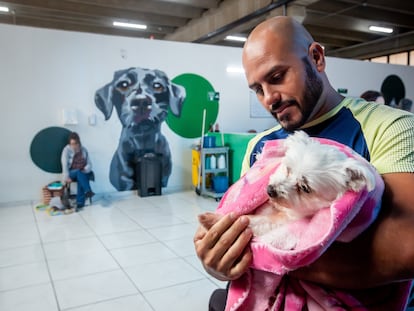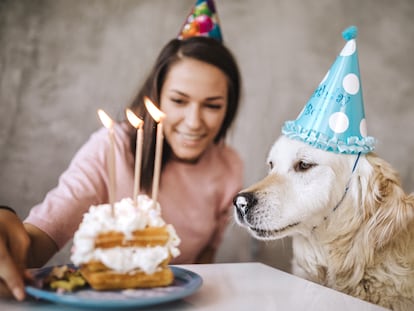What to do when cats and dogs get old
Canines and felines reach senescence at different ages according to their breed. Signs include gray fur and loss of vision and hearing. In addition to veterinary checkups. Moderate exercise and a specific diet help them to preserve their quality of life

Dogs and cats reach old age later and later, thanks to the care they receive at home that preserves their health. “Geriatric check-ups allow us to detect certain illnesses on time, before they progress, and in that way we can stop their evolution to maintain the animal in good physical shape for longer, like, for example, with a cardiac pathology,” explains Manuel Lázaro, veterinarian and spokesperson of the College of Veterinarians of Madrid. But at what age does a cat or dog get old? Large canines age earlier than smaller ones. “The average lifespan of a large dog is between 11 and 13 years. Small ones can live up to 13 to 16 years, and cats from 14 to 17 years,” he says.
There are many signs that a dog or cat has gotten old. Lázaro lists the following: “Graying fur, vision and hearing loss, dental plaque, moderate osteoarthritis or thinning skin.” Veterinary check-ups for older cats and dogs are important to ensure their quality of life during their last years. It is important to pay special attention to symptoms like fatigue, cough, drinking and urinating a lot, constipation or difficulties with movement,” Lázaro says. He also mentions that animals of advanced age can suffer from a condition similar to Alzheimers, known as cognitive dysfunction, which affects, according to the expert, 25% of dogs older than 12.
Before old age comes the so-called fragility syndrome, characterized by the animal’s risk of getting sick. The expert notes that the syndrome includes symptoms like “loss of muscle mass, less resistance to infection, deterioration of cardiac, renal and hepatic function, hormonal changes or osteoarthritis.” The expert advises paying attention to those signs to detect them early.
Preserving your pets’ health is possible if they follow a specific senior diet. “A reduction in the quantity of protein, as well as phosphorus and sodium, is lower in calories and has positive effects, because the decrease in protein favors better liver, kidney and heart function,” Lázaro says. And he adds other guidelines: “Moderate exercise, good hydration and following the animal’s vaccination calendar.”
The first signs that an animal is getting old
Cats tend to camouflage their signs of decline better, due to the fact that felines are predators that avoid appearing vulnerable in order to survive. But there are signs that indicate the beginnings of aging in cats and dogs. Pedro Raf, spokesperson of the College of Veterinarians of Madrid, mentions the following:
- Lack of interaction with the owner.
- Inadequate elimination of urine and feces. In cats, this may mean outside of the litterbox; for dogs, outside their walk hours.
- Excessive meowing or barking.
- Unusual behaviors, such as staring at the walls.
- Spatial disorientation, lack of activity, apathy or excessive sedentarism.
- Not responding to or recognizing the owner.
- Unusual episodes of aggressiveness.
Cats and dogs share things in common with people who are aging. They may also suffer from brain deterioration: “It may start to appear when they are seven or eight years old in breeds with less longevity, like mastiffs or boxers, and in general in large breeds. In the smaller ones, it tends to start at 10 years old,” he explains. For such cases, he recommends medications that improve the animal’s brain oxygenation.
Sign up for our weekly newsletter to get more English-language news coverage from EL PAÍS USA Edition
Tu suscripción se está usando en otro dispositivo
¿Quieres añadir otro usuario a tu suscripción?
Si continúas leyendo en este dispositivo, no se podrá leer en el otro.
FlechaTu suscripción se está usando en otro dispositivo y solo puedes acceder a EL PAÍS desde un dispositivo a la vez.
Si quieres compartir tu cuenta, cambia tu suscripción a la modalidad Premium, así podrás añadir otro usuario. Cada uno accederá con su propia cuenta de email, lo que os permitirá personalizar vuestra experiencia en EL PAÍS.
¿Tienes una suscripción de empresa? Accede aquí para contratar más cuentas.
En el caso de no saber quién está usando tu cuenta, te recomendamos cambiar tu contraseña aquí.
Si decides continuar compartiendo tu cuenta, este mensaje se mostrará en tu dispositivo y en el de la otra persona que está usando tu cuenta de forma indefinida, afectando a tu experiencia de lectura. Puedes consultar aquí los términos y condiciones de la suscripción digital.
More information
Últimas noticias
There is as much life left to discover on planet Earth as that which is already known
Dozens presumed dead, around 100 injured in fire at Swiss Alps bar during New Year’s celebration
Is porn for women different from conventional porn? We spoke to those who make it
Cartagena de Indias is sinking: What can the city do to mitigate it?
Most viewed
- Reinhard Genzel, Nobel laureate in physics: ‘One-minute videos will never give you the truth’
- David King, chemist: ‘There are scientists studying how to cool the planet; nobody should stop these experiments from happening’
- Sinaloa Cartel war is taking its toll on Los Chapitos
- Oona Chaplin: ‘I told James Cameron that I was living in a treehouse and starting a permaculture project with a friend’
- The Interoceanic Train, the Mexican alternative to the Panama Canal











































